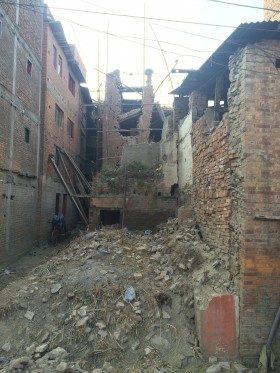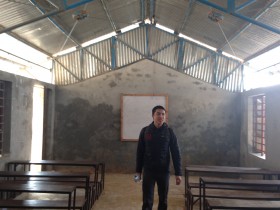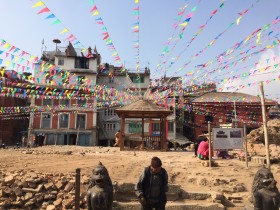
The former site of the completely destroyed Kasthamandap temple, supposedly built from the trunk of a single tree and the namesake of Kathmandu.
This is part of a recurring series in which we share reports from Harvard students who have traveled to South Asia with support from a SAI grant during the winter session.
Click here to read more reports from students.
By Austin Wu, Harvard College ’16 and Patrick Xu, Harvard College ’16
Austin and Patrick spent part of their winter session in Nepal, conducting research on their project ‘Nepal Earthquake Relief Effort Data Usage Narrative.’
Introduction
As statistics students, we are naturally drawn to data, numbers, and analysis. Following a devastating earthquake in Nepal in the spring of 2015, we came across an article which revealed the massive inefficiency of the Red Cross in Haiti and warned of similar wastefulness in Nepal. This led us to begin thinking about how data can potentially be used to optimize the delivery of relief aid. However, once we traveled to Nepal, we learned an important lesson in data analysis: the context behind the data, including the events which generate it, are just as important, if not more important, than the data itself. The following presents some of the insights gained from our trip in South Asia in January, 2016.
Context
At 11:56 AM, on April 25, 2015, Nepal was struck by an earthquake of magnitude 7.8, followed by a magnitude 7.3 aftershock just three weeks later. The death count from these two earthquakes and the number of secondary hazards that followed, primarily landslides, has been estimated by the government to be around 10,000, although data from Nepal’s more rural regions is widely considered inaccurate. Many thousands more were physically injured or struggled with mental health issues after this deeply traumatic experience.
We arrived in South Asia hoping to talk to locals about their experiences surrounding all three stages of disaster: preparation, destruction, and recovery. We hoped to understand the perspective of the everyday citizens, relief organizations including international NGOs, and government agencies charged with providing support in disaster situations.
After spending a few days in New Delhi, we moved to Kathmandu, Nepal’s earthquake ravaged capital. According to many people we met, Nepal is currently in one of the the most tumultuous times in its young history. While the earthquake had struck 8 months previously, the roads were still littered with rubble and many people still inhabited crack-riddled brick structures. Winter was settling in, and it was heartbreaking to see that thousands of Kathmandu’s citizens still lived in makeshift corrugated tin roof shelters or even worse, plastic tarp tents, heating themselves with firewood on the streets. It certainly did not help that Nepal as a whole was experiencing a severe fuel shortage, the result of blockades in the southern part of the country because of disagreements over Nepal’s new constitution. City-wide blackouts were also common and we usually had electricity for less than 8 hours a day.

Patrick is hard at work at the LIG and AL offices. Sara and Quincy (on the left), along with other employees, are working on inputting survey results into Kobo Toolbox.
The sad reality, made worse by winter, is that many Nepalis have realized that they cannot rely on the government or NGOs for relief. Many have simply moved on with their lives, a testament to the resilience of the people. In fact, during our interviews, “resilient” was the most popular adjective most used to describe the people of Nepal. We saw this as a double edged sword: while the Nepalis’ resilience is helping them through the hardest of times, it also means that they often readily accept the status quo of inefficient governance without demanding change.
We spent our first week working with Local Interventions Group (LIG) and Accountability Labs (AL), two separate organizations that had partnered together to work on anti-corruption and government accountability tracking. For the last few months, they had been administering a nation-wide survey with the support of Ground Truth Solutions, an international accountability group with experience in Sierra Leone and Haiti. We lent our analytical skills to the team, providing statistical summaries of the survey results and producing trend analysis of how the situation has changed over the last few months after relief workers arrived in Nepal. Our final deliverable was a regression model that proposed various factors which are the most highly correlated with overall satisfaction – in other words, we identified which government and NGO interventions were producing real results from the perspective of earthquake victims. Over the next couple weeks, we spoke with numerous locals and interviewed representatives from local and international organizations.
The following sections describe what we have learned from these invaluable conversations with some important stakeholders in disaster response and relief. In each section, we attempt to relay stories that we have heard and insights that we have gleaned, both specific to the Nepal earthquakes and to relief work in general.
Data Project
During our first week in Kathmandu, we partnered with Local Interventions Group and Accountability Labs, run by Pranav Budhathoki and Narayan Adhikiri respectively, for a data project. The two organizations partner in administering surveys in the 14 most affected districts after the earthquake.
At a high level, it was fascinating to be able to actually gauge citizen sentiment towards disaster relief. From our analysis, we began to understand the potential of data to provide a backbone for future discussions and arguments. Without real numbers and hard data, it is easy for issues to become partisan, especially in a country as deeply politicized as Nepal. Furthermore, data analysis and the presentation of open data are tactics that people can use to enhance transparency and stifle corruption. Because financial reports and spending, as well as results from government programs, can be clearly visualized and understood, it holds government officials and other spenders accountable for their promises.
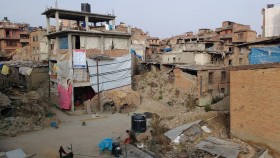
Patrick is hard at work at the LIG and AL offices. Sara and Quincy (on the left), along with other employees, are working on inputting survey results into Kobo Toolbox.
One obvious objection that is raised about “open data” is the lack of data literacy. Like most outsiders to the region, we had the impression that South Asia, and Nepal in particular, lacked technological competence, let alone an ability to manipulate data and perform data analysis. Speaking with technology-centric NGOs, particularly Kathmandu Living Labs (KLL), has made it clear that this is not necessarily the case. In the last decade, young people have embraced mobile and computer technologies with open arms. Like in more developed western countries, information technology (IT) and computer science (CS) courses are rapidly becoming the most popular subjects in Nepal’s for-profit university system.
As we learned more about the “industry” of disaster relief, we began to visualize disaster response and relief as a supply and demand problem, yet a difficult one to optimize due to lack of information. This is not to trivialize the emotional and humanitarian component of disaster relief, but it is very important to balance the availability and need for financial and material assistance. For example, immediately after the earthquake, billions of dollars in cash and relief items flooded in and were meant to be distributed to earthquake victims scattered throughout the country. With proper data about victims, including their location and primary needs, the demand for assistance can be properly matched by the supply of relief aid. Unfortunately, in Nepal, these data were late to arrive or simply don’t exist, and attempts to deliver supplies were complicated by treacherous terrain. A significant portion of Nepal’s rural population lives in areas inaccessible by cars, so it is important to be prepared if relief organizations must commit resources to days long hikes, or even helicopter flights in extreme cases, to reach these places.
The aforementioned model is vastly simplified however, and there are many caveats. First, the simple tracking of both demand and supply side of data is extremely difficult. From the supply side standpoint, it is very hard for a governing body to track all the aid that comes into the country, especially if small organizations or individual actors are acting independently from larger organizations and government institutions. We’ve heard this story many times, where good-hearted people and organizations who want to help, purchased relief items and flew to Nepal with no real plan, heading only to areas easily accessible from Kathmandu before quickly returning home. Some made the relevant authorities known of their plans, but many did not, making it very difficult to track all the aid that was flowing into the country.
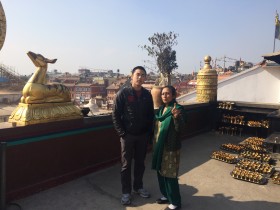
We chartered a private tour of Kathmandu Valley with a focus on earthquake damaged areas. Here is Austin with our guide Sujan at Boudhanath Stupa, one of Kathmandu’s several World Heritage sites, and one that was very damaged after the earthquake
Lack of internet penetration is the primary obstacle for capturing information from the demand side. KLL was able to crowdsource responses from people needing help, and created QuakeMap, a web platform that geotagged and visualized where and what people needed. Since most affected people lacked Internet access, many reported their needs through SMS text messages or called into a hotline managed by volunteers, who entered victims’ needs on their behalf. But QuakeMap was built in reaction to the earthquake, and it took over a week to start collecting data, spreading only by word of mouth. But time is precious in these catastrophes. A scaled-up system, pre-deployed and taught to local administrators for widespread use, might be able to collect demand side data more quickly.
NGOs, International Donors & Volunteers, and their Stories
Even before the earthquake struck Nepal, there were innumerable NGOs operating in Nepal, addressing the full range of human development and environmental issues; but immediately after the earthquake, most NGOs transitioned into a relief supply delivery and emergency aid role.
While we like to think that NGOs operate completely altruistically, we have already mentioned that not all NGOs do good. Many are vehicles for money laundering and embezzling, organizations that exist to grow personal wealth, rather than to help others. Thus, accountability and transparency with NGOs is incredibly important. Many of the organizations that we’ve worked with emphasize complete financial transparency, as they meticulously track their financials and will reveal it to anyone who asks.
An issue that comes to light from the lack of accountability of NGOs is that international donors who have little knowledge of the legitimacy of organizations may donate to organizations that may not be using their money in a proper way. Sadly, of the $4+ billion that flowed in Nepal, countless funds were undoubtedly lost to corrupt NGOs capitalizing on a horrific situation to grow personal wealth. In addition to corruption, human resources is complex issue faced by and perpetrated by many NGOs. From what we have gathered from our interviews, these issues are universal in NGO culture, but particularly rampant throughout Nepal.
We found that NGOs could be readily distinguished as local organizations or international NGOs (INGOs). Originally we did not anticipate the importance of local organizations in disaster relief, but our conversations revealed their integral and diverse roles. One heartwarming story we heard is that of Nepal’s National Cycling Team, which was biking on the day of the earthquake and quickly rushed to assist affected people in a nearby area. They realized they could reach a locations other organizations could not, because they travelled off-road on their bicycles. It was later reported that they generated tens of thousands of dollars of funding and continued to use their special talents to reach disaster stricken areas.
Another extremely important issue that is frequently ignored while delivering aid is the understanding the local culture. This is mostly problematic when INGOs come into a country to help without the proper context and background. Two relevant stories exemplify this disconnect. For example, In Nepal, there is a large difference between households and families, as multiple families live in a given household. This is a result of a particular tradition in Nepal, where a son will live with his parents until they pass away. Yet, when attempting to deliver corrugated galvanized iron (CGI) sheets for building homes, organizations made the mistake of equating families and households. Because the average family size in Nepal is much smaller than the average household size, the organizations delivered far fewer sheets to each household than are required. In addition to the lack of sufficient materials, this has also created the unintended consequence of the explosion of households in some districts. Citizens are learning that aid is distributed by households rather than families, so if they split families up, they can collectively receive more aid; thus many families have separated.
One of the saddest stories we came across is that organizations, in an attempt to craft disaster preparedness protocols, educated citizens to hide under tables to seek protection during earthquakes. These drills were adapted from Western countries, where this technique works well. But in Nepal, many houses are built so that ceilings and walls will fall inwards during earthquakes. Because many of the ceilings and walls are cement, people were crushed to death when the tables that people hid under collapsed under the weight of the debris. Many disaster preparedness techniques and procedures in Nepal have been taken from India and Western agencies, but it is clear that they need to be adapted to unique Nepali conditions.
NGOs and INGOs undoubtedly have a crucial role to play in disaster relief, as they are incredible at generating funding from donors, both at an individual and institutional scale, and transporting volunteers to countries to disseminate aid. They are far from perfect, however, and from the aforementioned examples, it is apparent that there is still much room for improvement.
Media
Before we arrived in Nepal, we only had a vague idea of the media’s role in the disaster response situation, but after our interviews, its role has become much more evident. Directly after the earthquake, rumors spread quickly, ranging from reasonable to farfetched. In hectic, post-disaster situations, the media can be a source of truth to help calm the citizenship. This is helpful not only in dispelling rumors that have little veracity, but also in providing information to citizens about potential secondary hazards, entitlements that citizens deserve, and developments in the news.
The media can also serve as a check for both the government and NGOs, which is incredibly important in a country where both are largely seen as corrupt. It is no surprise that social media also has played a role in connecting communities and helping to disseminate information rapidly. Facebook is incredibly popular for citizens with internet access, and following the earthquake, many people used Facebook to communicate with family and friends across the country and around the world.
Government
The consensus among everyone we’ve talked to is that the government should be the primary coordinator of relief. The United Nations has established what is called the cluster system, where organizations working on like-minded missions, such as hygiene, education, and child protection, meet on some periodic basis to discuss their projects and trade best practices. The cluster heads are government officials, while the humanitarian cluster coordinators comes from the United Nations. Thus, ideally the government can direct aid. But in such a hectic situation as with Nepal, and with the limited bandwidth of the government, it seems that the government was not as strong as it should have been.
If the government is able to control all relevant parties, and this seems nearly impossible, then it can properly direct organizations to reduce duplication and increase the number of people helped. Although there is undoubtedly a bottleneck in needing to run everything by the government, the trade off seems worth it. The government can also push international organizations to understand the culture of the people that they may be unfamiliar with. As mentioned earlier, it’s crucial to understand, from a cultural standpoint, the people that you’re helping.
Importance of Disaster Preparedness
In almost all aspects, Nepal was not prepared for the 2015 earthquake; according to the people we talked to, while almost everyone was aware of the historic 1934 Nepal-Bihar earthquake, nearly no one actually had a personal earthquake contingency plan and were subsequently caught off guard. And although there have historically been disaster management policies, no centralized government agency took control to provide a unified response. As NGOs poured in, the largely autonomous and publicly respected Nepalese Armed Forces played a crucial role in providing emergency services.
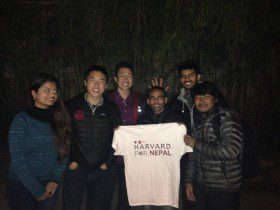
Patrick and Austin pose with the Local Interventions Group and Accountability Labs teams, who we worked with for a week.
To learn how other South Asian governments deal with disaster preparedness, we met with the National Disaster Management Authority in New Delhi, India, which specializes in disaster preparedness. During our meeting, Mr. Nawal Prakash relayed to us one particular success story: in 2007, a typhoon swept through India and killed over ten thousand people; recently, a typhoon of similar severity and location of landfall struck, but killed fewer than one hundred people because of proper monitoring and enhanced warning and evacuation techniques.
While it is nearly impossible to monitor impending earthquakes like one watches an incoming weather system, there are certain mechanisms that can give advance warnings – for example in Japan, earthquake sirens can alert the entire country in seconds after detecting seismic activity hundreds of kilometers away, giving citizens a crucial few seconds to run outside.
It is important for all stakeholders, not just the government, to prepare for disaster.
Conclusion and Thoughts
We came to India and Nepal with a relatively vague research question and little understanding of what to expect from our time here, but we have left with a much better understanding of the unique role played by citizens, NGOs, the media, and the government in Nepal, following their catastrophic earthquake. While Nepal is a unique situation in several ways, particularly its difficult topography and very low human development index, we believe that lessons learned from Nepal are universal. When other disasters inevitably occur, we will monitor closely to see how our learnings fit into this new narrative. To truly optimize disaster relief, more research will need to be conducted to simply provide a foundation on which this conversation of optimization can be had. We hope that the narratives we have depicted and the lessons we have learned will be a small part of this foundation.
The weeks have been emotional, moving, and trying, but we are both incredibly appreciative to have been able to have this experience. We are incredibly grateful to all those that participated in our interviews and helped us with our research. We are also incredibly grateful to both the South Asia Institute and the Asia Center for funding this trip — without all of the generosity of these aforementioned groups, none of this would have been possible.

